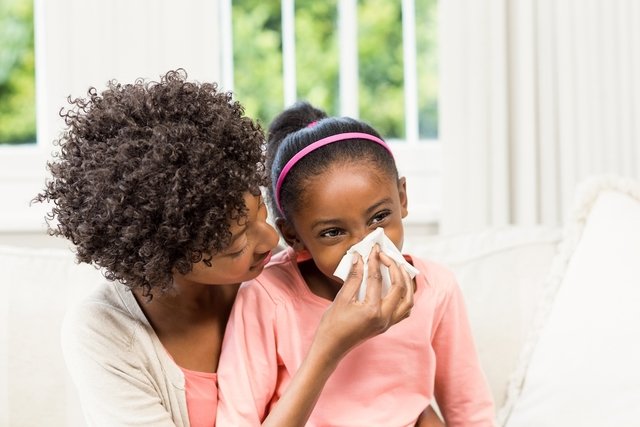A cold is a viral infection that affects the upper respiratory tract, causing symptoms such as runny nose, frequent sneezing, stuffy nose, watery eyes, body pain, feeling of general malaise and low-grade fever, in some cases.
The cold is caused by common viruses, mainly rhinovirus, and can be transmitted from a person through direct contact and with respiratory secretions from an infected person that remain suspended in the air after coughing, sneezing or speaking, for example.
Cold symptoms usually disappear after 4 days, without the need for specific treatment. However, the doctor may recommend that the person rest, drink plenty of fluids and use medications that help alleviate symptoms and promote nasal decongestion, for example.

Cold symptoms
The main symptoms of a cold are:
- Runny or stuffy nose;
- Frequent sneezing;
- Tearing eyes;
- Pain and itching in the throat;
- Chills;
- Mild headache;
- Body ache;
- Feeling of general malaise.
Furthermore, in some cases there may be a cough, temporary loss of smell and taste or a low fever, for example. See more about cold symptoms.
It is important to consult your general practitioner or otorhinolaryngologist in cases of intense flu symptoms in adults. For children, it is recommended to always take them to the pediatrician, regardless of the intensity of the symptoms.
How long does a cold last?
Cold symptoms typically appear 2 to 3 days after infection and usually last 2 to 4 days, improving without the need for specific treatment.
How to confirm the diagnosis
The diagnosis of a cold is made by a general practitioner, otorhinolaryngologist or pediatrician through evaluation of symptoms and health history.
Make an appointment with the general practitioner in the region closest to you:
Taking care of your health has never been easier!
Generally, additional tests are not necessary, but if the doctor suspects other health conditions, such as COVID-19 or pneumonia, tests such as a COVID test or chest X-ray, for example, may be requested.
Difference between flu and cold
Although the flu and cold are respiratory diseases, they can be differentiated by the intensity of the symptoms. Flu symptoms tend to be more intense and last longer than those of a cold. Furthermore, it is common for a high fever to occur in the flu and involvement of the entire lung, in some cases, which is not observed in a cold. Learn how to recognize flu symptoms.
Furthermore, the viruses related to flu and cold are different, as are the complications that can arise if the immune system does not correctly combat the infection, which can lead to the development of pneumonia, in the case of flu, or otitis and sinusitis, in the case of flu. case of a cold, for example. See more details on how to differentiate the flu and the cold.
What causes the cold
The cold is caused by more than 200 types of viruses, but rhinovirus infection is the most common, and occurs most frequently in spring and autumn.
Furthermore, another virus that can also cause a cold is the adenovirus.
How transmission happens
The cold is transmitted through direct contact with people infected with the virus or through inhalation of droplets of saliva or nasal secretions released when the infected person coughs, sneezes or talks, for example.
The cold virus enters the body through the nose, eyes or mouth, and therefore, touching objects contaminated with the virus, such as doorknobs, plates, glasses, towels or cell phones, and then touching the eyes, nose or mouth, is also a form of indirect transmission of the cold.
How the treatment is carried out
Cold treatment must be carried out under medical supervision and varies according to the severity of the symptoms, as the body itself eliminates the cold virus within a few days.
The main treatments for the cold are:
1. Rest
Resting is important to help the body recover and alleviate cold symptoms, as well as allowing the body to use all of its energy to fight the infection.
2. Increase fluid consumption
Increasing fluid consumption is important to keep the body hydrated, especially in the case of children and the elderly, who are at greater risk of dehydration. Know how to identify the symptoms of dehydration.
Therefore, it is recommended to drink more water, or consume liquids such as natural and unsweetened fruit juices, teas, smoothies and soups, which help maintain hydration and also contain necessary nutrients when the person is unable to eat.
3. Gargle with water and salt
Gargling with warm water and salt has an anti-inflammatory and antiseptic action that helps reduce inflammation in the throat and relieve sore throat or discomfort.
To gargle with warm salt water, place a teaspoon of salt in a glass of warm water and mix. Gargle several times a day.
4. Nasal wash
If the feeling of a runny or blocked nose causes a lot of discomfort, you can wash your nose with 0.9% saline solution, as it helps to fluidize nasal secretions, facilitating their elimination and relieving a blocked nose. See how to wash your nose correctly.
Read too: How to unblock your nose: 11 natural and effective ways
5. Cold medicine
Cold medications must be prescribed by a doctor, and generally include:
- Analgesics or anti-inflammatories such as paracetamol, dipyrone or ibuprofen: they are used to relieve fever, sore throat, headache and tiredness;
- Nasal decongestant spray: serve to reduce nasal congestion;
- Expectorant syrupssuch as ambroxol or guaifenesin: facilitate the elimination of nasal secretions;
- Mucolytic syrupssuch as acetylcysteine or bromhexine: they make nasal secretions more fluid, facilitating their elimination.
In addition, it may also be recommended to use antihistamines, such as loratadine or desloratadine, to open the nasal passages and help relieve congestion and sneezing.
During pregnancy, flu medications should only be used if indicated by the obstetrician, as they can interfere with the baby's development.
Read too: Cold and flu remedies during pregnancy
6. Home remedies
Homemade cold remedies help alleviate cold symptoms, as they have anti-inflammatory, antioxidant and immunity-stimulating properties, in addition to promoting hydration.
Some home remedy options that can be consumed in case of a cold are lemon, garlic and ginger tea, mint tea and star anise tea, for example. Check out other home remedy options for colds.
7. Food for a cold
It is important to have a light, easily digestible diet to help the body recover faster.
Furthermore, it is important to include foods in your daily diet that help strengthen the immune system, such as foods rich in vitamin C, such as oranges, pineapple, strawberries and acerola, for example.
How to prevent a cold
It is important that measures are adopted to help prevent infection and transmission of swine flu, such as:
- Avoid contact with people suspected of having a cold;
- Always cover your nose and mouth when coughing or sneezing, using a disposable tissue that must then be discarded;
- Wash your hands after coughing or sneezing, even if you have used a disposable tissue;
- Avoid touching surfaces and touching your eyes, mouth or nose;
- Clean surfaces that may be contaminated with disinfectants;
- Avoid sharing personal objects or toys with other children;
- Avoid staying in a closed environment for a long time or with little air circulation.
In addition, you should wash your hands regularly, using water and neutral soap, for at least 20 seconds before rinsing, in order to prevent colds and prevent the transmission of the disease.



